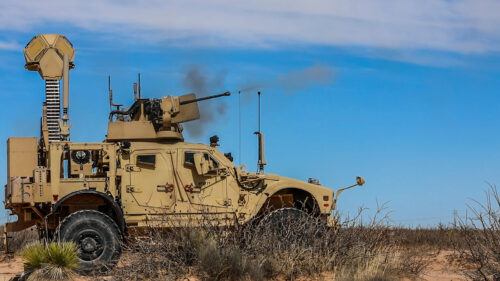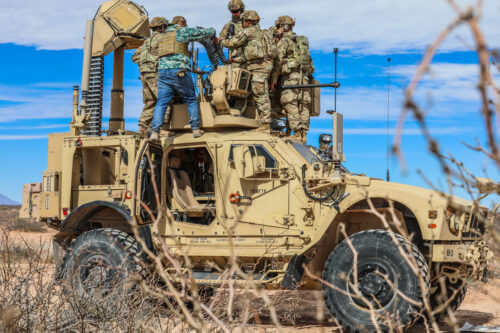Soldiers from the 44th Infantry Brigade Combat Team recently conducted a critical live-fire exercise at McGregor Range Complex, New Mexico, showcasing the capabilities of the M-LIDS (Mobile-Low, Slow, Small-Unmanned Aircraft Integrated Defeat System). M-LIDS is a mobile counter-unmanned aerial system (C-UAS) designed to detect, track, and neutralize drone threats encountered during deployments.


The M-LIDS system employs a two-pronged approach to combat drone threats. It consists of two mine-resistant ambush-protected (MRAP) all-terrain vehicles (M-ATVs) working in tandem.
One M-ATV focuses on kinetic defense. It utilizes on-board radar to detect and track incoming drones. This vehicle also boasts a remote turret system, the Reconfigurable Integrated-weapons Platform (RIwP®) developed by Moog. The RIwP® turret is equipped with a high-resolution Leonardo DRS EO/IR sensor for precise target identification. Additionally, it houses a powerful Northrop Grumman XM914 (30mmx113mm) cannon that fires proximity-fused ammunition, proven highly effective against drones. This M-ATV further enhances its defensive capabilities with Raytheon Coyote missiles, capable of engaging a range of drone threats (Group 1 through Group 3) at extended distances.
The second M-ATV prioritizes non-kinetic defense. It carries electronic warfare (EW) technologies from SRC, designed to disrupt drone control signals and prevent them from carrying out their missions. This two-layered defense system offers a comprehensive solution for countering drone threats.
Leonardo DRS plays a vital role in the M-LIDS program. They are responsible for ensuring seamless operation and communication between the various components of the system, including the radar, turret, sensors, and EW suite. This integration process guarantees optimal performance on the battlefield.
Leonardo DRS also handles the assembly of the M-LIDS system on the MRAP platforms and delivers these integrated vehicles to the Army. Furthermore, they provide ongoing engineering support, constantly improving the M-LIDS system based on user feedback and the evolving nature of drone threats.
For more information, hit the Source below